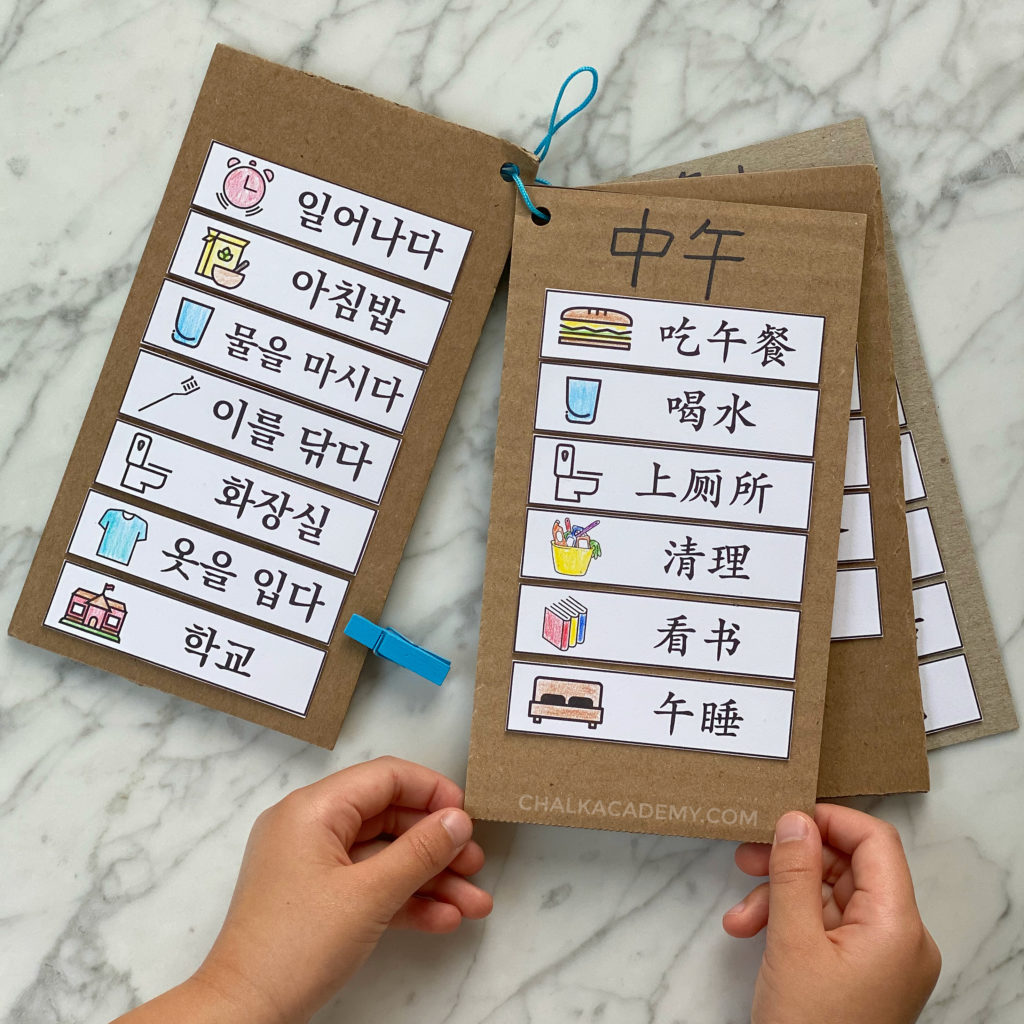How to Raise a Trilingual Child? Pros and Cons to Consider

As a pediatrician who’s celebrated many trilingual milestones against the odds, parents often ask us for advice on how to raise a child trilingual. Our children have learned and spoken one, two, or three languages at home at various points in the past decade. Here are common parenting questions I hear about raising trilingual kids:
- Can young children learn three languages at once?
- What are the benefits of teaching three languages to a child?
- How do you balance it all?
- Are there any downsides to growing up trilingual?
Brief background about our trilingual family
Over the years, our children have been exposed to English, Chinese, and Korean.
- English is the community language in our small town, USA.
- Chinese has been their main minority language through me. When my first child was two years of age, I switched from speaking in our dominant language to our minority language at home.
- Korean is our family’s other heritage language; my children were exposed to Korean since birth. Because they learned from prior nannies and we no longer have childcare, they have since largely forgotten Korean.
During this marathon journey of raising multilingual children as a non-fluent parent, I’ve needed to catch my breath, step back, and look at the big picture.
Here’s what has worked for us so far. I’ll also share the pros and cons of teaching kids three languages simultaneously.
How to raise a child trilingual
No matter how many languages your child is learning, the key is ensuring each language is accessible and attractive at home.
Linguistics expert Barbara Pearson emphasizes that children are more likely to learn when “families are proactive and provide daily activities for children in the minority language.”
Create an immersive trilingual environment
If you live in a multilingual community, your child will naturally be surrounded by languages. Relatives, neighbors, signs, books, activities, and music offer multi-sensorial language input in a linguistically diverse area.

If your location is linguistically limited, you must consciously create opportunities for your child to grow up trilingual.
In addition to speaking the non-dominant language consistently, there should be auditory and visual triggers in the daily routine.
Here are five key steps to teaching a foreign language at home by creating an immersive environment.
Be a brave role model when speaking minority languages
To maximize the chances of your child growing up trilingual, they need to hear each language as much as possible. Often, this means speaking Chinese, Spanish, Italian, Russian, French, Dutch, Korean, Arabic, Hindi, or another minority language outside of the home.
Understandably, if your town has significant bullying and discrimination problems, sticking to English may feel like the safest option.
But whenever possible, even a few phrases can have a meaningful impact in normalizing your target language in your community. Your confidence can inspire your child to embrace their unique languages.
Follow your trilingual child’s interests
What does your child want to do today?
Whether or not you are a native speaker, always consider this question first. The secret is to observe what captures your child’s attention to find the answer. Listen to what they want to share with you.
If kids develop a positive association with a certain person, place, or thing while using the minority language, they will be more likely to speak it.
Whenever my children have shown resistance to their minority languages, nurturing their interests has helped to overcome the challenges.
For instance, if your trilingual child wants to learn a Mandarin Disney song, singing will be more productive than using Chinese worksheets.
If your trilingual child is fascinated by wildlife, tap into that passion with the Montessori Animals of the World activity and amazing National Geographic animal shows in Chinese.

Know that language quality could have a greater impact than quantity
If you want to raise a trilingual child, time is a big challenge. Exposure will be divided unequally throughout the week for kids who hear more than one language.
When my children were younger, I tracked our family’s language exposure out of curiosity.
Although English language exposure was less than 25% of the week, it was the dominant language. This was especially true for my son, thanks to a strong bond with his dad and their love of LEGO toys and sports.
Related: Encourage A Child to Love the Minority Language with 5 Strategies
Similarly, when my daughter attended preschool part-time, she began speaking English more spontaneously than Chinese and Korean.
Because she was making new memories with friends at school, English powered its way to the forefront of her mind.
Therefore, parents, caregivers, nannies, and language teachers must speak consistently in the target language and make it meaningful.

Try this: 20 effective ways to get kids to speak Chinese or any language.
Benefits of growing up trilingual
If all of this sounds like a lot of work, that’s because it is! If you want to raise a trilingual child, it has to be worth your time and energy.
So, when children learn three languages, what are the benefits? The social-emotional perks are similar to the bilingual advantage.
If you want to raise a trilingual child for connection and interaction with family members, this would be the most priceless benefit. This is especially significant if both parents have different native languages from each other as well as the community.
Beyond your family, exposure to multiple languages opens a child’s heart and mind to different cultures and people.
Downsides to teaching a child three languages
Although there’s plenty of research on the benefits of raising bilingual kids, there is far less data on growing up trilingual. Some cognitive benefits of bilingual development have not been replicated in research on trilingual people.
Related: Teaching Minority Languages to Kids: A New Approach Can Help
The cognitive burden of growing up trilingual
Although research suggests that learning three languages may have extra benefits in older adults, it might be a burden to some children.
A study in the International Journal of Bilingualism suggested that “trilinguals may face increased executive demands from managing additional languages and increased memory demands from encoding, storing, and retrieving more linguistic information. Also, the challenges of retrieving memory in a different linguistic context may be increased in trilinguals relative to bilinguals.”
The emotional burden of raising a trilingual child
More is not always better.
More activities mean more responsibilities and costs. And more languages might mean less energy and time for other priorities and relationships.
When my second child was a toddler, he tended to mix English, Chinese, and Korean into the same sentence. Unfortunately, my husband had trouble understanding him.
My husband often felt excluded from our conversations. It wouldn’t be fair for him to wait months or years for our younger child to become fluent, articulate, and compartmentalized in his multilingual speech.
Language should connect, not divide a family. We all want to understand and be understood by those we love.
During family time, I support my husband by encouraging our children to speak English rather than our minority languages, just as my husband supports our multilingual endeavors by listening to Chinese songs and audiobooks during car rides.

On another personal note, I experienced significant burnout trying to maintain Korean as our family’s third language.
In addition to preparing Chinese teaching activities for my kids, I researched Korean resources.
I spent too much time looking for Korean children’s books, Korean songs, and Hangul alphabet activities.
After dropping our third language, I immediately experienced grief as well as an immense sense of relief.
Are your children growing up bilingual or trilingual?
How is language learning going for your family? How is your family balancing two, three, or more languages?
If your children are growing up bilingual or trilingual, I’d love to learn more about your experience. Please feel free to share in the comments below!


Really funny how a childs brain work.
Our Child is now 6 (almost 7) we live in AoTeaRoa New Zealand. I am half German, half French, my wife is from Slovakia, our little girl was born at home we continuously speak German to me and Slovakian to her mum. At school the teachers teach English and Maori, she get exposed a lot to Chinese, Spanish and Japanese.
We currently struggle explaining the teachers it is normal she is stage 2 in English instead of other kids Stage 4 or 5 already.
I think you have to continuously keep on teaching it is superhard but in the end your kid will be prepared for a global world
I am so glad to have found his blog as my baby is almost three months and I am trying to create a trilingual(the same exact three languages as you) environment with him. Our environment is a bit different as I am Chinese-American and we are living in Korea currently and will probably move to China a little later this year. Currently, I am living with my inlaws and on a daily basis, he is exposed to Korean. I am responsible for teaching both English and Chinese. My question is during this age, if he is hearing all three languages on a daily basis, will he get confused? For example, in our daily routine we always have a set of English songs, but then I switch to Chinese when speaking directly to him. And then when his grand parents play with him, it will be in Korean.
What a wealth of information you’ve put together. We are a family of 4 in Los Angeles, our children are 3 and 1. We are raising our children with four languages and it’s been a challenge but also so much fun! I speak English to them and my husband speaks Hindi, when he can, since he works long hours. My older daughter goes to French school, she’s in PK. And finally, our babysitter spoke Chinese to my children, but she left us a few months ago and since then I’ve been scrambling because I don’t want all the investment we’ve put into chinese education to fade away. This is how I found your site and I’m contemplating putting the effort into learning Chinese also. Great job and hats off to you for leading by example.
Hi Shundell, Thank you for taking the time to read and share your family’s language journey! How wonderful that they have been exposed to so many languages and cultures at a young age. I hope this post about 10 Ways to Find a Language Teacher can be helpful for finding more community support for each language!
Thank you so much for sharing! I’m just starting with my 3 year old son and 1 year old daughter. I feel like I will not get there with Chinese since my hubby only speaks English. I gained so much insight after reading this post.
My babies will keep what they can. There will be a language that will get lost and it will be ok. I will just do my best with korean. Teaching korean alone has been a struggle and for me. I would get info from ur blog and teach chinese has inspired me but I will stay up more nights studying Chinese and I get nothing done at the end of the week. I willl still try but for now I will focus more of what I know and try to provide Chinese a different way. Thank you again for sharing.
Hi Maria! Thank you so much for taking the time to read and also share your story! Our circumstances seem similar, and I would love to hear how your family is doing these days!